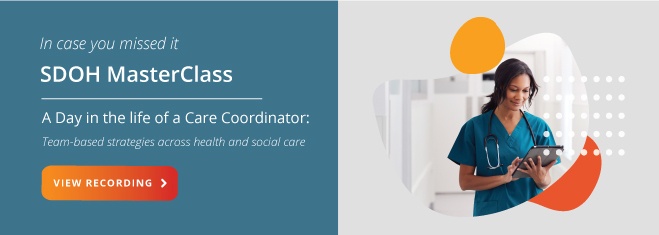We know that the root causes of health trace back to social conditions such as housing, socioeconomic status, food security, and education, to name a few. Being fully aware of an individual’s unique health and social challenges is essential to deliver effective, whole person care.
We are seeing an increase in efforts to collect social determinants of health (SDOH) data. However, there is still a long road ahead in getting healthcare providers to incorporate social needs screening into their routine appointments with patients.
There are several widely used social needs screening tools, and one of them is the Health Leads Screening Toolkit.
In this article, we cover:
• The benefits of social needs screening
• How the Health Leads Screening Toolkit works
• Challenges of social needs screening
Activate Care had the pleasure of chatting with Amy Hulberg, formerly of Health Leads, and the co-developer of this popular toolkit.
The Health Leads Screening Toolkit includes best practices for screening for social needs, plus a sample screening tool, and a screener questions library. The sample tool screens for the most common unmet social needs: food insecurity, housing instability, utility needs, financial resource strain, transportation, exposure to violence, and socio-demographic information. Some optional social need domains are childcare, education, employment, health behaviors, social isolation & supports, and behavioral/mental health.
According to a study reviewing SDOH screening tools, doctors may fail to identify health-related social needs in an estimated 50% of patients who have such needs. This is due to gaps in routine screening, a lack of information/education about screening tools, and lack of training on how to screen properly.
When talking with Amy about the difficulties around social needs screening, she drives home the shared concern of the lack of social needs screening education. This is what helped inform her development of the Health Leads Screening Toolkit. As she told us, "It’s a way to push everyone towards best practices, honoring the need for a validated instrument when there isn’t one, and maintaining the value of the work being done.
The benefits of social needs screening
Social needs screening provides the opportunity to think critically about your own population
According to Amy, a common issue is that healthcare providers tend to avoid asking their patients about social needs because they aren’t in the position to help solve that need. Amy says this isn’t the right mindset: “Even if you can’t solve your patient’s hunger, knowing about it is still clinically relevant. If you know a patient is struggling with their electricity, then you know not to prescribe them medication that requires refrigeration… don’t be afraid to ask.”
How the Health Leads Screening Toolkit works
The Health Leads approach is unique from other social needs screening approaches
The Health Leads Screening Toolkit highlights and combines in one resource multiple validated instruments and research. Amy's experience running programs and doing screening and referrals nationally helped her gain an understanding of the frequently asked questions. The Health Leads Toolkit is easy to implement in any organization and can be used to find scales for specific populations. This is valuable because a tool such as this one should be making care providers' jobs easier and not an added burden. That's why it only contains questions and scales that have been designed based on thorough testing and research.
What’s next?
The assessment aspect of the screening process is often overlooked. Screening informs the care provider about the possible need, but an assessment is necessary to determine the solutions and understand what referral is needed. Amy says that it’s important to understand that a referral is more than just a few clicks of a button or the passing of a 211 number. The relationship that forms by truly assessing who is in front of you and tailor your treatment to their needs is powerful.
Challenges of social needs screening
Cost-effectiveness and ability to meet needs are key concerns
Once screening is implemented, care providers can then begin building the data to show how important the work in addressing SDOH is for treating health issues. It also helps demonstrate the effectiveness of addressing a social need. This information is useful in displaying what an intervention can do and how all of this work ties back to medical care. Amy describes it as “filling the hole in care and honoring the need for science and data.”
COVID-19’s impact on the screening process
The decrease in patients physically entering clinics due to COVID-19 has made the screening process more complicated, as most health systems still utilize paper forms for screening. However, screening is of course even more critical now than ever, as the number of people going hungry, jobless, and homeless is steadily increasing.
Amy says that now is the time to take action and shift the way things are done - and we agree. It’s not realistic to merely try to continue to make current processes work. It’s time to change the way things are done, and healthcare organizations need to adopt the methods and technologies that work and evolve with these uncertain times. One thing is for certain - things will never be the same. Amy recommends that aspiring screeners start with incorporating small ways to start screening virtually. For example, include a screening survey on Zoom when the patient logs in, and get into the habit of initiating conversations around social determinants of health.
An all hands on deck, screen-to-intervene approach is necessary to address social determinants of health in your population successfully. Tools such as the Health Leads Screening Toolkit can streamline the screening process, allow for consistent data tracking, and help care providers uncover needs and overcome any barriers.
